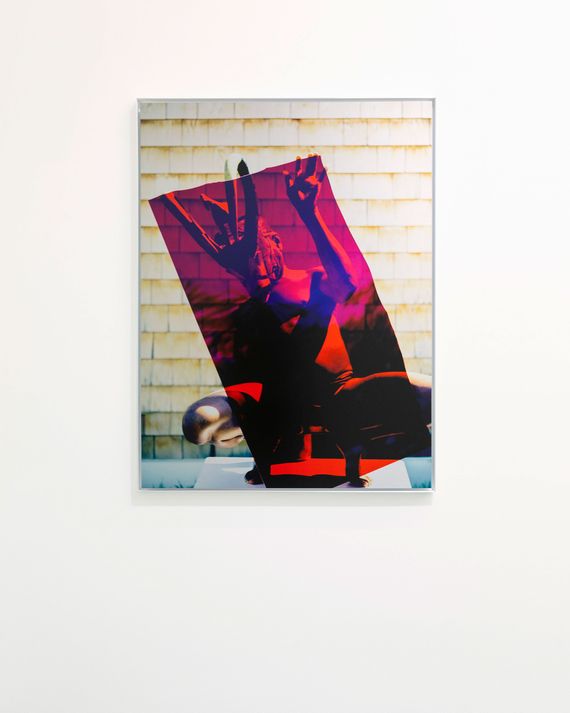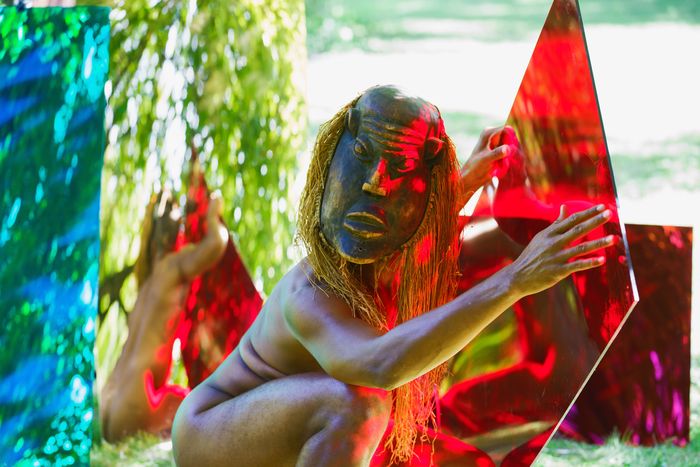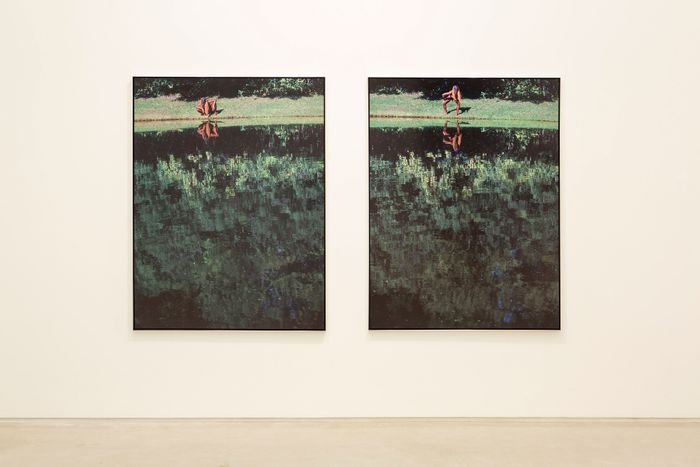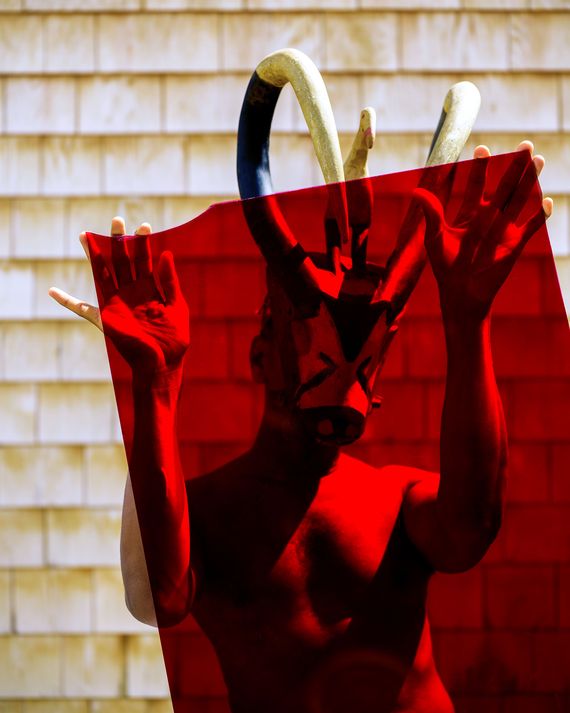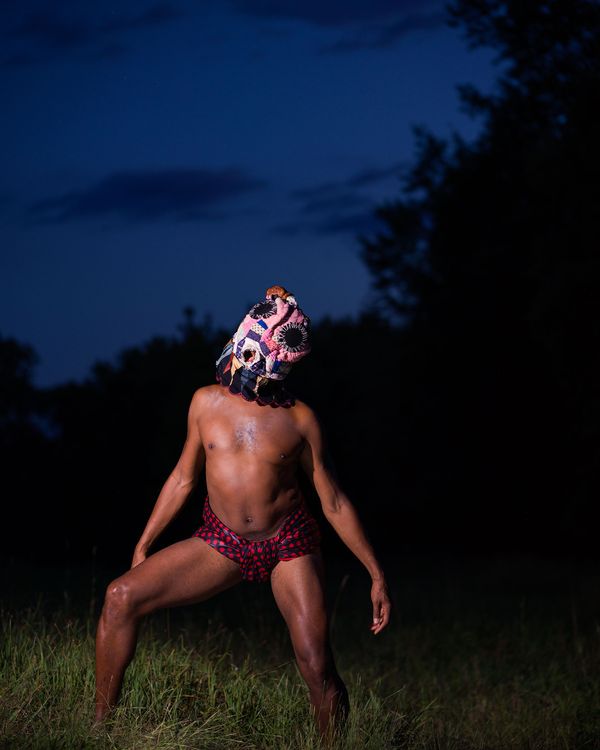
Lyle Ashton Harris’s solo exhibition, “Flash of the Spirit,” at Salon 94, features 12 medium- to large-scale, Fanonian self-portraits. In the images, the artist, in the nude wearing various West African masks, transforms himself into an enigmatic figure in lush landscapes, engaged in a spiritual performance. Some are filmic, Afrofuturistic images of saturated abandon and contemplation that seem to conjure the past and future as a way to make sense of the present. For Harris, central to the gestures these images capture is the question: “What does it mean to take my own figure and act out?”
Over the course of his three-decade-long career, Harris has experimented with self-portraiture and masquerade to toy with expectations of race, gender, and the hegemonic white gaze. He created his first photo series “Americas” in 1987, at the height of the AIDS crisis, and a few years later, his follow-up “Constructs” was included in the Whitney Museum’s landmark 1994 exhibition “Black Male.” In these black-and-white portraits, Harris in white face and a peroxide blond wig against a traditional studio backdrop, shows us what it means to have a body that refuses to behave. He purposely fails at gender, race, and sex, appearing in agony and ecstasy. In doing so, he makes a point that the 19th-century black poet Paul Laurence Dunbar said: “We wear the mask.” Harris’s art asks, “When will it end?”
Throughout his career Harris, 53, who was born in the Bronx but lived for a period of his childhood in Tanzania, has examined the ways that community, history, tradition, and desire shape his subjectivity. More recently, he’s taught and worked in Ghana, which has further influenced his work. In this show, which also marks a return to self-portraiture after nearly 15 years, he is interested in probing a new set of questions that deal with aging, family, and imaging black queer identity as a part of African Diasporic history.
What is it about photography, the medium, that drew you to it and keeps you engaged with it?
I’m not sure. Maybe it’s something about all the truth and veracity of photography, which has obviously been disputed, but there’s something about the verisimilitude. The idea of the document is something I find deeply sustaining; the ability to be able to, not only have it function as a document in terms of capturing impulse, but also its ability to reimagine identity. I am also fascinated by the apparatus of photography in its most violent sense. In terms of the role it plays in constructing notions of beauty and how that rubs up against, let’s say, the allure of seduction. What has been fulfilling is the ability to be able to take part in that dialogue, reimagining what could actually be.
This new series, “Flash of the Spirit,” is your first self-portrait series since 2002. What took you back to self-portraiture?
“Flash of the Spirit” became an opportunity to really think about what is important to me today. I had to reconsider what self-portraiture meant for me at 53, particularly on the heels of doing, “AKA Daddy,” the project about mourning I presented at Participant, Inc. This [consideration] coincided with me receiving a promised gift from my uncle: a mask. It is a golden Goli mask from the Baule people. It is a beautiful object and something about the mask transported me back to being a young teenager, growing up in the Bronx and visiting my uncle where I would see this mask. His daughter and I were very close, and it reminded me of when we were in college and how we would go to clubs like Area, where we met Basquiat the first night we went out there. It was the Wednesday before he had the cover of the New York Times magazine barefoot. He brought about a hundred-dollar bottle Champagne and offered us some. With the mask, all these memories came back.
Your history with the self-portrait is legendary. There’s the early “Americas” and “Constructs” series that was shown in the landmark Whitney Museum exhibition curated by Thelma Golden; “Black Male,” that changed the way we think about masculinity and the black queer male body.
The idea of self-portraiture for me is about embodiment and what it means to reimagine the self as a way of looking at the past, to deal with the present as ways to think about the future. As Essex Hemphill said to me early on, it’s not self-portraiture for the sake of doing the portrait itself. The [image] becomes a figure or entity through which I can deal with a series of experiments. “Constructs” registered so deeply with people, not just because it was me per se, but because it’s a black man, a figure, enacting various gestures. Some are playful. Some are confrontational. There is almost a rupture in notions of masculinity.
“Constructs” for me is really an implicit critique of Mapplethorpe.
I would say there’s definitely an engagement.
Why not critique?
It’s a critique of, not Mapplethorpe per se, but the way with which the colonizer’s gaze is the dominant representation of blackness because it was the only gaze that was permissible. It’s less a critique of him and more about the hegemonic way in which culture works. And I’m not talking about the way the alt-right thinks about culture, I’m talking about liberalism, the people in the center who see culture through one lens.
What Essex Hemphill told you reminds me of what Hilton Als said about the first-person essay: “The essay is not about the empirical ‘I’ but about the collective — all the voices that made your ‘I.’” He’s writing about himself but really about the multitude of identities within his experience. I see that in your pictures.
I think, in a way, it’s about trying to create skin around a space, which is the unknown.
In “Flash of the Spirit,” it feels like you are after transformation or transcendence. Your identity is being mitigated through the masks in very performative ways.
“Flash of the Spirit” is more about the abundance of plurality of who we are. And for me, I think it speaks to just the multiplicity of locations I occupy as an American, as a human, as a man, as an elder, as queer, as a son. It’s about our trajectories.
Some of these images were shot in Provincetown and on Fire Island, two traditionally white gay vacation spots. Was that about claiming space?
The prevailing notion around whiteness in 2018 also prevails in those locations of privilege and leisure. What does it mean to somehow provoke the African diaspora in these spaces? What a lot of these photographs do is link our legacy not only to let’s say Frederick Douglass but to our queerness, as part of the transatlantic transmission. Where most people see [queerness] as an American phenomenon, I see it as something that is endemic in Africanism itself. I’m not saying [Africanism] is gay per se, but I’m trying to make a link back. If you think about the movie Black Panther, the progenitors of Afrofuturism — Samuel Delany, Octavia Butler — were sidelined by the mainstreaming of a super hero film.
You think Black Panther plays a role in the erasure of queerness in Afrofuturism?
Why is it that our queerness, our contribution to that discourse, is written out of that? Atavistic heteronormativity is mapped onto Afrofuturism in 2018. It can be much more open and reflect the lives that we actually live.
So these new photographs are an intervention?
Yeah, an engagement, a play, an intervention. Part of the strength of this series lies in the fact that I don’t think of them as a critique. This work is different from “Constructs,” where there is clearly a much more concerted critique, if you will, of gender, race, and the idea of a construct, formally the backdrop itself, is exposed to call attention to a level of artifice. Where in these new works something else happened: The figure is transported outside into the landscape.
Thinking about black futurism, I am reminded of your “Ektachrome Archive” from the 1980s and early ’90s. It features artists, thinkers, and filmmakers who are now stars of the art world who were then young creatives just trying to make it, like Marlon Riggs, Essex Hemphill, bell hooks, Hilton Als, Thelma Golden, and Glenn Ligon. The archive shows their work; their legacies have become our inheritance. Were you thinking about the future when you were documenting your friends?
Did I consciously say, “I need a document because I need to have this in the future?” No. It was much more intuitive. My grandfather was a race man; he was a disciple of W.E.B. Dubois who grew up in Albany. He documented his friends and family in over 10,000 Ektachrome slides. So in a lot of ways, it made sense that that would be something I would do, but obviously at the time there was a certain sense of urgency. Also, the camera, in the spaces I found myself in, became a tool or a weapon or a comfort or control that helped me negotiate space.
A control?
Living in Tanzania as a child, I couldn’t always express what it meant to be an African-American from the Bronx, then coming back, expressing what it meant to live for two years in Africa led by the first independent president of Tanzania was difficult.
Was living in Dar es Salaam in the 1970s a liberating experience for you?
The violence that comes out of racism, homophobia, and white supremacy for a moment didn’t exist. It was an idyllic, Edenic situation where I could be who I was. I could explore my sexuality at a young age there where it began to emerge.
There are a couple of works in this series that seem to speak directly to the white Western gaze, like “Afropunk Odalisque.”
I think in a way they do, but what I love about this new work is the abandonment of that. I feel like in these works there’s a sense that that work has been done — it’s been abandoned; it’s the imagined future. I’m thinking about our bodies and pleasure.
This is what you mean by the spirit.
There was a force, if you will, a higher power or entity that was guiding the work. I’m interested in trying to bring that energy forth. What you see is a necessity for self-care and self-protection because there is so much trauma around the body right now. So what does it mean to return to the figure through very formal, chromatic means as a way to think about how we reinject pleasure, energy, and sustenance into the day-to-day. I think art has the potential to do that.


